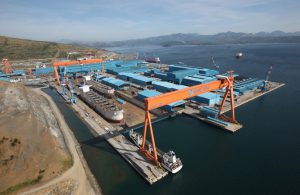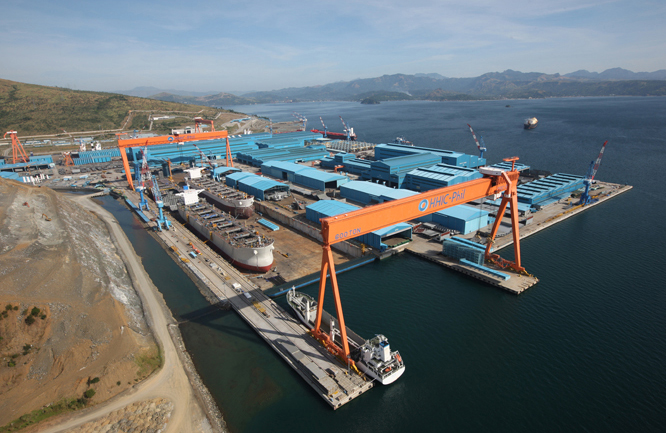
The Maritime Industry Authority (Marina) has created a far-reaching strategy to promote and develop the Philippines as a shipbuilding and ship repair (SBSR) hub in Asia.
“We want a shipbuilding industry that is supportive of the shipping sector, both domestic and overseas, that provides the sector an opportunity to acquire locally built ships at relatively lower cost and of a quality comparable to that of foreign-built ships,” said Joshua Rafale Tolin, Marina Shipyards Regulations Service (SRS) officer, during a presentation at the 2nd Marine Philippines Maritime, Shipbuilding, and Offshore Event on June 17.
Marina envisions transforming the country into a shipbuilding nation with a strong capacity, a ship repair hub in Asia, and a center for regional maritime research and development.
Tolin said the country is currently the fourth largest shipbuilding nation in the world in capacity, following Japan, Korea, and China. Since 100% foreign ownership of SBSR companies is allowed, this has encouraged more foreign shipyard operators to set up business in the Philippines, with a strong focus on the export market, he added.
To achieve Marina’s goals, Tolin said the key is to modernize the country’s shipyards. Toward this end, the Shipyard Association of the Philippines (SHAP), the first national organization of SBSR operators, was launched during the event to serve as the sector’s representative voice.
A technical working group composed of seven representatives from shipyard companies was also created to start the necessary work to formalize the organization, such as creating its by-laws and securing government licenses.
Marina also intends to improve industry standards by developing a shipyard capacity and capability measurement system, acquiring ISO certification for Marina’s SRS division, and adopting a quality, safety and environmental management system for local shipyards.
This will be complemented by skills training and development programs for shipyard workers.
To stimulate growth of the local shipbuilding industry, Marina aims to adopt standard ship designs for the different types of domestic ships, gradually restrict ship importation, and adopt a government importation scheme for bringing in shipbuilding materials and parts from foreign manufacturers and sub-manufacturers.
As for becoming a ship repair hub, Marina seeks to enhance the cost competitiveness and production efficiency of Philippine shipyard services. And to ensure continuous supply of shipyard materials and parts for shipbuilding and ship repair projects, customs bonded warehouses outside of designated economic zones will have to be accredited.
A review and improvement of the ship construction, conversion, alteration, repair and dry-docking policy is also in the offing, as well as the development of systems and procedures.
In order to become a research and development hub in Asia, Marina plans to develop green ship designs and promote the use of LNG-fuelled ships.
The agency will revisit ship designs for ways to enhance the efficiency of engine and propulsion systems, as well as improve hull designs. There should also be a reliable SBSR database, including data on the use of the latest naval architecture and marine programs, Marina said.
Other issues
Tolin said that of the 107 licensed SBSR entities in the country, only seven shipyards have facilities for constructing or repairing big ships. Of the rest, only 14 are designed for work on medium-sized ships, and 99 have capability to service only small ships.
Furthermore, Tolin said the scarcity of attractive long-term financing plans undermines efforts to build up the country’s domestic fleet.
Basic requirements for shipbuilding and ship repair projects such as steel plates, equipment, and parts from ancillary industries are not yet economically available locally.
Due to the cost and time it takes to construct a ship in local shipyards, ship owners prefer readily available second-hand ships coming from other countries.
Building ships in Philippine shipyards costs more and takes longer to complete compared to having them constructed overseas.
Drydocking and repair are also more expensive in the Philippines — around US$500,000 for a 5,000-deadweight tonnage container ship which will take a month to complete vis-à-vis $240,000 in two weeks at a Chinese shipyard.
In a separate interview with PortCalls after the presentation, Metro Manila Shipyard Associations’ Lambert Sianghio said other industry challenges include government bureaucracy and red tape, the 12% value-added tax on the importation of materials (the exemption of VAT under Republic Act 9295 expired last year), limited power supply, and shortage in skilled manpower in some areas.
Sianghio said Luzon power supply is adequate for now but its instability curtails expansion plans of some shipyards. In Mindanao, supply is insufficient, slowing down expansion. Though power barges can be used, this entails additional expenses, Sianghio added.
Aside from power issues, Sianghio said there is a shortage of skilled workers in General Santos where some shipyards are located, necessitating the hiring of workers from Metro Manila. He said there is a need to provide 30% additional workforce to augment the shortage.
Furthermore, Sianghio called for the removal of fly-by-night shipyards. These are float repairers licensed by Marina that undertake repairs while the vessel is afloat and not dry-docked. Sianghio said float repairers usually just lease space and cranes, unlike shipyards that invest in land and equipment.
Good prospects
Despite all issues, Marina is optimistic for the industry because of the growing export market for ships made by foreign and locally owned or managed shipyards in the country, like Tsuneishi in Cebu and Hanjin in Subic.
More ships of bigger tonnage capacities are also being built in the Philippines. Recently, carrier CMA CGM ordered vessels with over 21,000 twenty-foot equivalent units of capacity from Hanjin.
In addition, Tolin said the country has “favorable sites for shipyards,” such as the Subic Bay Metropolitan Authority, Cagayan Export Processing Zone Authority, Aurora Pacific Ecozone, Zamboanga City Special Economic Authority, and Maritime Industrial Park at PHIVIDEC Industrial Estate in Misamis Oriental, all offering different incentive schemes.
Tolin said the country is likewise an ideal location for SBSR activity for its several advantages: pool of qualified and well-trained skilled manpower, protected areas for ships against rough seas and strong winds, adequate space and water depth for anchorage near the yard, sea channels favorable to sea trials, and distance from a community.
Marina plans to fine-tune the industry’s roadmap together with SHAP and hopes to launch the same once the new organization is formalized. – Roumina Pablo





